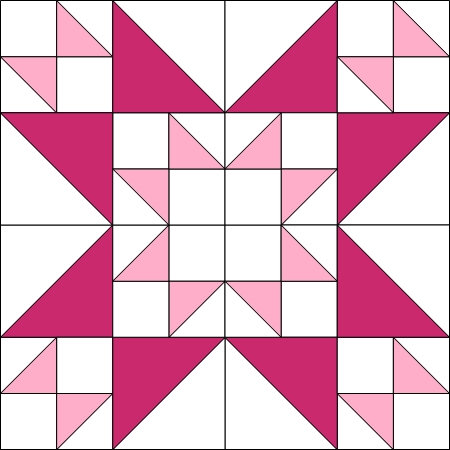
My local quilt guild, Piecemakers of Idaho, started a Block of the Month (BOM) challenge in January. Most of the quilt blocks were 12″ blocks. However, one of the quilt blocks was 16″. I really didn’t want this block that big. After all, I was not doing a medallion quilt. It really needed to be the same size as the other blocks. Unfortunately, the finished size of the blocks were not listed on the pattern.
Many of you probably have experienced a time when you needed to resize a quilt block. Maybe you used the copier method or even redrew the block. Today’s post is all about how to resize a quilt block using the grid method. Although this method will not work with every block. It comes in handy for many traditionally pieced blocks. By the way, this resizing method does not use a copy machine. The math is fairly simple…bonus!
To resize a quilt block our practice piece will be the Atlas Star, designed by Gina Perkes of The Copper Needle. This block was part of the 2018 quilt challenge on the National Quilt Circle. You can obtain the block and a color sheet at their website here.
Analyzing the Block
The first step when resizing a quilt block is to analyze if the block is grid worthy. I love the ease of resizing when working with blocks like this one. Simply because it is easy to see that it will fit a grid. Analyzing the block, it is easy to see there are several half-square triangles, flying geese, and a large square block in the center.

When I look at the whole block, I know I could lay a grid over the block and all the seams would be on the grid lines. The picture shows the grid lines. This grid is a 4 x 4 grid. But it can also be made into an 8 x 8 grid block. As I analyzed the picture, I always look for the smallest element. So I first broke it out into the bigger 8-grid before I determined that a 4-grid would work.

A Little Math
By using the 8-grid I could see easily each of the elements, whereas the 4-grid combines some of the elements in the center block. Once I determined the block is either a 4 or 8-grid I looked at the cutting chart to see what size the center is since it is a square.

Fabric F is the center block that is 4.5″ square. This is the cut size and not the finished size. To determine the finished size, remove the half-inch seam allowance; making it a 4″ square. So if I am using an 8-grid, and I know the center is 4″ I then know that each grid block is 2″. There are 8 grid blocks and if each is 2″ the whole block equals 16″. If I knew the finished size was 16″ to begin with, then I could have simply divided 16 by 8 grid blocks. However, the pattern did not state the finished size. That’s why knowing the center square helped me determine the size of the block.
Let’s Resize
To resize this quilt block for a 12″ block, I need to figure out what size each grid block would be. I would simply divide 12 (finished size) by 8 (grids). I have to admit, I do not always have a calculator in my sewing room. It is something I should get. Since the calculator is not handy, I can continue to use the grid but since 8 does not go into 12 easily. Many of you may already know the answer, but for those of us who are math challenged I transformed the 8-grid into a 4-grid. Easily, I knew each of the 4-grid blocks is 3″ and then divided that by 2. By dividing by 2, I easily got the size for each grid block in the 8-grid. The size for each grid is 1.5″. Remember, this is the finished size. Using the original cut guide, remove the seam allowance before changing the cut size to the new cut size and then add the seam allowance back. Here is the new guide.

Will this work on sizes of grid blocks?
Although you could resize all grid blocks this way, not all grid blocks sizes lend themselves to a good cutting size. For example, if I wanted to increase a 10″ block to a 12″ block that fits a 5-grid that would not be easy. After all, 5 grids into a 12″ block leaves 2-2/5″ or 2.4″. I don’t want to cut that let alone being able to calculate that in my head. In this case, you would have a couple of choices. This might be where a copier comes in handy. Simply load the 10″ quilt block and copy it at 120%. To determine the percentage you need to copy at simply take the size of block and divide by the original size of the block.
Then cut out each of the blocks, but remember this is finished size so you need to add your seam allowances. Alternatively, you could just add a border around the block to get it to the 12″. I hope this helps you when you decide to resize your quilt blocks.
Check out our store for pieced and foundation paper pieced patterns, embroidery patterns, and more!
